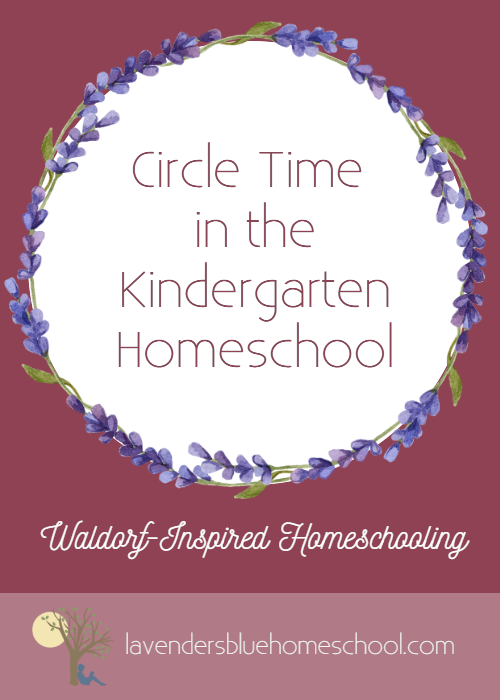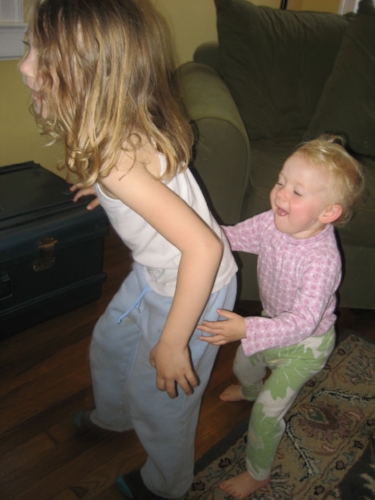Circle Time in the Kindergarten Homeschool
In a Waldorf kindergarten (and in the early grades as well), music and movement happen throughout the day but there is also a special gathering each morning called circle time. A circle time is just a time of the day when you sing songs together, recite verses, use movement, and do fingerplays. Those four elements are pulled together into a seasonal or story-based theme. Older children might do traditional singing games during circle, practice tossing and catching beanbags, and other developmental movement exercises. In the early grades, circle becomes not only a music and movement gathering, but a time to practice math in an active way, work on drama and speech exercises, and practice the recorder. A formal circle time is at the heart of a Waldorf school program, and I think it can also be a wonderful practice for homeschoolers.
Why Music and Movement Matter in Early Childhood
Waldorf education is truly holistic and from kindergarten all the way through grade twelve, the curriculum strives for a balanced education of the head, heart, and hands. One way that we see this emphasis is that the arts are taught as discrete subjects but are also used as vehicles for learning in all of the other subjects. In kindergarten, young children learn through play and through imitation, making this an ideal time to build literacy in an active way, through singing, speech, movement, and storytelling.
During circle time, children build fine motor skills with fingerplays and gesture and gross motor skills with skipping, galloping, balancing, jumping, dancing, clapping, and more. They are practicing basic music skills such as singing, rhythm, and keeping a beat with the body and the voice. And circle time builds literacy through rhymes, speech, vocabulary, improving phonemic awareness, and memorizing.
Incorporating Music, Movement, and Speech at Home
Your homeschool kindergarten does not need to look like a Waldorf school kindergarten program, nor should it. There is no right or wrong way to incorporate music and movement into your kindergartener's day. The important thing is to do it. Some families choose to integrate speech, singing, movement, and fingerplays throughout the day at times that feel natural. Other families make circle time a part of their rhythm. And a third option (and what we enjoy doing in our family) is to do both.
All of the circle time elements can be practiced throughout the day. You can sing while you go for walks, while you do the housework, while your kids are in the bath....There are so many opportunities to sing each day! You might enjoy playing movement games during your outside time and practicing fingerplays before you do a craft or modeling activity.
A circle time is just a beautiful way to bring all of these elements together into one activity. Forming a circle together is a lovely way to gather in the morning, promote connection and reverence, and work inclusively with your children of different ages. There's also the benefit of rhythm, consistency, and repetition when you do a formal (but fun!) circle time.
HOW TO DO CIRCLE TIME IN KINDERGARTEN
Think of circle time as a fun drama adventure that you take with your children. You are using songs, poetry, gesture, movement, drama, and games to express a seasonal story. The circle itself tells a story that mirrors what the children are taking in with all their senses when you are outside in nature. If you decide to make circle time part of your kindergarten homeschool, start by choosing a written circle from a resource you enjoy or gather songs and verses that are tied together by a seasonal theme, an upcoming festival, or the story that you are telling. Also choose a gathering song/verse (or try this one) and closing song/verse. Decide when circle time will fit into your rhythm. If you are just starting out, I recommend that you repeat the same circle 3 days a week for 3-4 weeks. A circle can repeat for a long time in kindergarten (as long as an entire season, with a few fresh songs mixed in over time), but my experience is that you can stretch it out much longer in a school setting than at home. Over time you will find the rhythm that works for you and your children. In the Lavender's Blue Kindergarten curriculum I designed the circle to evolve slowly over the course of the entire year so that you only need to learn one song or verse each week and it remains engaging for everyone.
We are turtles - can you tell?
A great circle has its own rhythm, its own in-breath and out-breath. It starts and ends with the same verses probably for the whole year or more. The middle parts are balanced with big active energetic movements and smaller hand movements. Play with gesture, with dancing freely, and with more controlled movements such as taking three hops to the left, clapping, walking or skipping in rhythm with your song or nursery rhyme. Use your body to mimic a flower, a bee, the rain, a frog on a lily pad. You can use props like silks, ribbon rings, bells, shakers, or rhythm sticks. Play with your voice, loud, soft, whispering. Include some quieter moments, sitting to sing a soft song, fingerplays, lying down to rest and breathe for a moment of stillness. Most of all, just sing and have fun together!
RESOURCES FOR KINDERGARTEN CIRCLE TIME
Here are some of my favorite resources for complete circle times.




